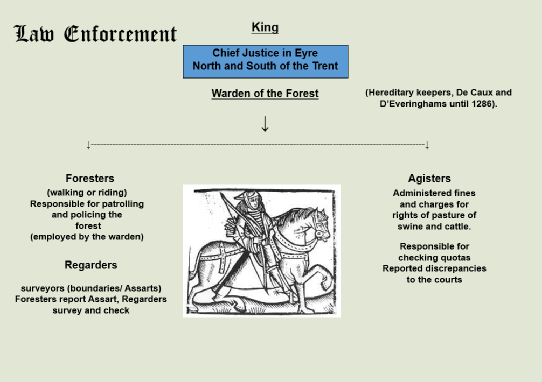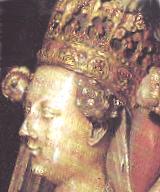Medieval Forest in England were areas of land subject to Forest Law.
The upkeep of this law required a complex system of administration. This administration was overseen by a Keeper of the Forest.
Every Medieval Forest in England therefore had such a keeper.
This was a person directly appointed by the King, who upheld the Forest Law, and oversaw the Foresters (the police force of the forest), Agisters (the tax collectors of the forest), and other Forest administrators, amongst other duties.

Picture: The legal structure of Sherwood Forest, ©Andy Gaunt.
These Keepers of the Royal Forests could be responsible for more than one forest.
In Nottinghamshire the Keepers of Sherwood Forest were for many generations hereditary.
These hereditary keepers of Sherwood Forest (or the Forests of Nottinghamshire), were the De Normanville, De Caux, the Birkin, and D'Everingham families. Who through marriage represented a long dynasty stretching back supposedly to the time of William I.
From the time of the De Caux family onwards, they were based at Laxton Castle, Nottinghamshire.
Much of what we know about the keepers of Sherwood Forest comes from research by Historian David Crook.
The elements discussed below regarding the De Normanville, De Caux, Birkin and D’Everinghams lineage is taken from his research.
In his paper 'Early Keepers of Sherwood Forest' (Transactions of the Thoroton Society 1980) David Crook suggests something along the lines of the following decent for these hereditary Keepers of Sherwood Forest:
Gerard De Normanville (in the time of William I)
Ralph De Normanville
Basilia De Normanville = Robert De Caux I
Robert De Caux II
Robert De Caux III
Maud De Caux = Ralph fitz Stephen (in the time of Henry II)
Maud De Daux = Adam Fitz Peter -
John of Birkin
Thomas Birkin
Isabella Birkin= Robert D'Everingham
Adam D'Everingham
Robert D'Everingham (lost keepership)
After: Crook, D. 1980. The early keepers of Sherwood Forest. Transactions of the Thoroton Society LXXXIV, 14-
Robert D'Everingham lost the keepership in 1287 through poaching.
Of the 11 hereditary keepers of the Forest up to 4 were women!
Among these one in particular would have a large impact on the history of Sherwood Forest, through her strength, fortitude, and determination…

Picture: Medieval women hunting
Of the first-
There were 2 ladies both named Maud De Caux's in the late 12th and early 13th century. One was the others aunt.
[It was the realisation that there were two Maud De Caux by David Crook which enabled the untangling of much previous confusion regarding the keepership of the Forest in these early times. Previously due to a missing part of a parchment they were believed to have been sisters].
From David Crook’s work we understand:
The first Maud was daughter of the Robert (III) De Caux, listed above, the second was his sister, her aunt.
The first of these held the keepership of the Forest and her struggles form an important part of the history of Sherwood Forest.
Maud De Caux (I) inherited from Richard (III) De Caux when he died circa 1167-
Maud was likely a minor at this time. She probably remained in the Kings Wardship and was seemingly placed in the care of Reynold de Lucy who also took over administration of Sherwood Forest (in her name -
When Maud came of age she was married to Ralph fitz Stephen. He was the King’s Chamberlain.
She subsequently, or rather they subsequently, had their position of keepers, and that of their heirs, confirmed in a charter by King John between 1189-
But things didn’t go smoothly… her husband died in 1202… and then…
King John stripped her of the keepership.
She spent 18 subsequent years struggling to get back the keepership which she had held by right.
She seems to have been the victim of the inherent sexism of the day…
“About 24 July 1220 Maud de Caux offered the king a fine of 80 marks for custody of the forests of Nottinghamshire and Derbyshire, excluding the royal demesne hays (CFR, 1219–20, no. 206), and including 50 marks which she had already offered for the same several years earlier, not long before 7 November 1217 (CFR, 1217–18, no. 3). These relatively mundane entries marked the end of a long period of 18 years during which Maud had sought to recover this, her hereditary office, passed down through her ancestors since it was created, probably by Henry I. It had been removed from her by King John after the death of her husband, the former royal chamberlain Ralph fitz Stephen, in 1202. Henry II had probably consented to, and possibly even arranged, their marriage, in order to place the forests in more secure hands than those of an heiress who may then have been under age. John had himself, as count of Mortain and holder of the two counties from 1189–1194 during his brother Richard I’s absence on crusade, confirmed the keepership of the forests to the couple and their heirs, but there were none, and evidently in 1202, now as king, he did not want to leave it in the hands of a widow who may not have wished to take a second husband. None of the previous holders of the office had been a single woman.”
(Maud de Caux and the custody of the forests of Nottinghamshire and Derbyshire-
In 1204 King John took over Laxton Manor for himself, which he gave the custody of, to one of Maud’s (male) relatives…
“For the remainder of John’s reign the forests were in the hands of temporary royal keepers, no doubt to Maud’s intense dissatisfaction. The king fell out with these officials on several occasions. In 1204 Richard de Lexington, possibly a bastard member of the same family, was given custody of the manor of Laxton, and the administration of the forest, except for the royal enclosures and park within it, which were administered by the sheriff of Nottinghamshire and Derbyshire. Richard held it on behalf of the king for three years. During this time Maud was given a royal gift of 10 marks from the income from her own land, which may have been particularly galling. In 1207, however, Lexington fell out of favour with John and the manor was taken away from him for maladministration of the forest. His chattels were sold for nearly £31, which he was later allowed to count towards the fine of 200 marks which he offered for the king’s benevolence, later reduced to 100 marks. The manor and forests were then administered by Brian de Lisle, a former household knight, as deputy to the chief forest justice, Hugh de Neville, from 1207 to 1215. From 1210 onwards Robert of Lexington, Richard’s son, worked as Lisle’s clerk, beginning at about the point at which his father was restored to royal favour.
…Richard de Lexington fell foul of John again during the civil war of 1215–17. At Berwick on 17 January 1216 he fined 100 marks and two palfreys for the king’s benevolence, while on 1 January the men of Laxton offered £100, payable within eight days, to have peace and to prevent their houses from being burned. It looks as though Richard had rebelled against the king, and that John consequently threatened to destroy the village when he arrived there on his way north, fresh from his capture of the rebel stronghold at Rochester; and that Richard, after fleeing north, thought better of his opposition to his royal master and submitted soon afterwards.”
(Maud de Caux and the custody of the forests of Nottinghamshire and Derbyshire-
In 1217, after the death of King John, Maud managed to have the keepership restored to her, only to subsequently have a run in with the Sheriff of Nottingham (Nottinghamshire) Philip Mark who was trying to take over the keepership for himself:
“The Caux custody of the forest and the family barony was only with some difficulty restored to Maud de Caux after John’s death and the end of the war in 1217. On 7 July 1217 Lisle was confirmed in the keeping of the forest of Nottinghamshire as before. On 6 October that year Maud made a fine of 60 marks with the young king, Henry III, for restoration of the barony (CFR, 1216–17, no. 15), and arrangements were made for the payment terms. Phillip Marc, sheriff of Nottinghamshire and Derbyshire, secure in the knowledge that the government needed him to retain control of the east midlands, which he supervised from his base at Nottingham castle, evidently did not withdraw his men from the forest. In April 1220 complaints were made about the number of his men there and the ‘grave exactions and oppressions’ they were making, and by the summer of that year complaints were reaching the government and the papal legate, Pandulf. Meanwhile Marc held an enquiry of his own into the number of officials the king needed in the forest and reported his findings, but was sharply told not to trouble Maud de Caux, whose forestership was confirmed while Marc was ordered to withdraw his men. Maud made a successful new fine of 80 marks for restoration of the custody as her hereditary right.”
(Maud de Caux and the custody of the forests of Nottinghamshire and Derbyshire-
This remarkable woman had fought for nearly two decades to get back what was rightfully hers.
We can see something of that strong character in the following:
“Immediately she began to act independently again, because not long afterwards she was involved in a conflict with the national forest administration. In November 1221 she had to be pardoned for replacing a forester without the assent of the chief justice of the forest, and for not making a regard of the forest when it was in her custody. After nearly two decades on the sidelines, the hereditary keeper of the forests of Nottinghamshire and Derbyshire was at long last able to make her presence felt, and she continued to hold the office until her death in 1224…”
(Maud de Caux and the custody of the forests of Nottinghamshire and Derbyshire-
As shown above Maud de Caux was keeper of the Forests of Nottinghamshire and Derbyshire.
The keepership Maud had fought for covered all of Nottinghamshire north, and west of the River Trent was under Forest. This area was divided into the ‘Forest of Nottingham’ (Sherwood Forest), the western half of Nottinghamshire situated primarily on the sandy soils which lie on the Sherwood Sandstone geology, and ‘The Forest of Clay’ the area east of this on the clay lands of the Mercian Mudstone geology.
Her keepership included the Forests of Derbyshire, which included the ‘High Peak Forest’ which covered much of north Derbyshire, and the ‘Forest between the River Erewash and the River Derwent’.
These combined Forest territories were vast.
As a further unfortunate twist this area was reduced by perambulations, resulting in Nottinghamshire with the loss of the Forest of Clay, and the northern half of the Forest of Nottingham from 1218 onwards, following the Forest Charter of 1217. This was not something any local keeper had control over and was linked to national affairs and the fall-
So the area Maud finally claimed having regained her control was significantly reduced from the original area.
However, perhaps most importantly, despite a shaky start, through her struggles the keepership remained in the De Caux family by hereditary right, and passed on down through the generations.
Much was therefore owed to this Maud De Caux from those who would come after, and she therefore played a very important role in the history of Sherwood Forest.
She was succeeded by her aunt, a second Maud De Caux, after dying without heir.
This Maud De Caux (II) had been married to Adam Fitz Peter (Seigneur) de Birkin, who died in approximately 1185 aged 49 years.
She may have held the keepership herself but she was very old when she inherited.
Their son John de Birkin was subsequently keeper, and eventually the role fell to their daughter Isabella Birkin.
Known as Isabella D’Everingham through her marriage to Robert D'Everingham.
They were the heads of the D’Everingham line of keepers who dominated the role through the 13th century.
The keepership was passed from Isabella, to her son Adam D'Everingham in an Inquisition Post Mortem on her death in the 13th century -
So, from the 11th (or early 12th) century to the late 13th century, through this age of hereditary keepership, it was possible for women to hold the role of Keeper of Sherwood Forest.
However, it should be stressed from the above that we should not over -
These women usually had to be married, and their husbands may well have assumed the power behind the title-
However we should likewise not underestimate them, or their ability to fight for, and wield that power as Maud (I) shows us.
The ability for women to hold the keepership changed when Robert D’Everingham was stripped of his rights and position of keeper of the forest and imprisoned in Nottingham Castle at the 1287 Forest Eyre following indiscretions in the Forest (poaching deer).
He was dead within a year -
Following this disgrace, the king removed the hereditary right of keepership from the D’Everingham family forever.
With the removal of hereditary keepership it became more difficult for a woman to hold the role, as it was inheritance which brought women to the post in the preceding period.
From this point forward, the keepership of Sherwood Forest was granted to favoured individuals for life at the king’s discretion. The role was often linked to the role of Constable of Nottingham Castle, and other titles.
Examples include Reginald de Grey, 1st Baron Grey of Wilton, who was Sheriff of Nottinghamshire, Derbyshire and the Royal Forests (including Sherwood Forest). He had previously been constable of Nottingham Castle.
His father John de Grey had also held the title.
He was the second son of the great Henry de Gray of Codnor Castle in Derbyshire, who was the ancestor of a great many lines of the Grey family including that containing Lady Jane Grey, Queen of England for a mere nine days in 1554.
Another example is Ralph Cromwell was Keeper of Sherwood Forest and Constable of Nottingham Castle. He was appointed by King Henry VI in 1437. He held land and a manor house at Lambley, in Sherwood Forest and would later build Tattershall Castle in Lincolnshire.
Ralph Cromwell held high office-
In such a male dominated world, where the keepership was granted by favour to people fighting for position, it would take a formidable lady to undertake the role of keeper of Sherwood Forest again.
In the 15th century, one such person may well have wrestled elements of the role of Keeper of Sherwood Forest for herself, and defied the sexist restraints of medieval life:
That lady was no other than Queen Joan.
She was queen consort of England as the second wife of Henry IV (1399-
 Joan was born the daughter of Charles II (the bad) of Navarre, and Joan of Valois.
Joan was born the daughter of Charles II (the bad) of Navarre, and Joan of Valois.
Her grandfather was John (the good), King of France (the second King of the house of Valois).
The Hundred Years War which ran from 1337 to 1453, was the dynastic struggle for the throne of France between the English Plantaganet dynasty and the French House of Valois. With both houses claiming the French throne.
Henry IV had seized the throne of England from Richard II in 1399, and married Joan in 1403.
You would think such a link between the royal houses would help to bring about peace-
She ruled as Queen of England until her husbands death in 1413.
Her step son Henry V accused and convicted her in 1419 of witchcraft.
Following a four year spell in Pevseney Castle she spent the remainder of her time living in Nottingham Castle.
There she seems to have assumed some of the rights of the Keepership of Sherwood Forest during that time.
Back in the times of Hereditary Keepership, the De Caux and D'Everingham families, had held a number of rights through their office.
Amongst these rights and privileges, was the right of Chiminage -
A record in the Court rolls for Nottingham from 1431 lists an 'Action by Queen Joan for ferm of Chiminage of Sherwood Forest':
'Johanna, Regina Angliae , per Galfridum Kneton, et Robertum Clapam, attornatos sous, queritur de Thoma Bayle, de Notingham, [de placito] debiti vjs. viijd'.
'Joan, Queen of England, by Geoffrey Kneveton, and Robert Clapham her attourneys complains of Thomas Bayle of Nottingham, [of a plea] of debt of 6s 8d'.
She claimed that Thomas Bale took from her the Chiminage of the Forest of Sherwood at the feast of St Martin (11th November) in the 9th year of Henry V until the same feast a year later-
In fact he refused to pay her it.. and so she brought a claim to the court for the money.
As well as the right of Chiminage, she also seems to have upheld the forest laws regarding the 'hambling of dogs' in the forest -
An 'action by Queen Joan for the ferm of the Hambling of Dogs within Sherwood Forest', dated 29 October 1433 was brought before the Nottingham court:
The claim presented that a Thomas Rothewood withheld from Queen Joan and Geoffrey Kneveton the rents from the hambling of dogs within the Forest of Sherwood (pro redditu expeditationis canum infra Forestam de Shyrewode).
It is claimed in the case that Thomas owed 12d for the rent.
Her counterpart in these claims is one Geoffrey Kneveton-
The office of Keeper of Sherwood Forest and that of the Constable of Nottingham castle was brought together following the demise of the D'Everingham dynasty's hereditary claim to keepership of the forest (as stated above)...
Perhaps with a member of the royal family also living at the castle alongside the Constable, these roles became blurred, with Queen Joan assuming some of the powers of Keeper of the Forest of Sherwood for herself...
(Andy Gaunt, first published 20/03/2012 -
Click here for more ‘Stories from the Forest’…
but it shows that the role of women in Sherwood Forest in the Medieval period should not be underestimated.
Andy Gaunt, first published 03/01/2012)
Click here for more ‘Stories from the Forest’…



Community Archaeology Nottinghamshire, Community Archaeology Derbyshire, Community Archaeology Leicestershire, Community Archaeology East Midlands, Mercian Archaeological Services Community Archaeology for Nottinghamshire, Derbyshire, Sherwood Forest, Leicestershire and the East Midlands. Community Archaeology Nottinghamshire, Community Archaeology East Midlands, Community Archaeology Leicestershire. Archaeological

Women Keepers of Sherwood Forest
Award Winners 2016
for "Engaging people in the heritage, history & archaeology of Sherwood Forest".





Some funders and partners:
World-











The Future of Sherwood’s Past
Project page links:
-
-
-
-
-
-
-
-
The Sherwood Forest
National Nature Reserve Archaeology Survey
-
Long term Research at
King John’s Palace:
Ancient Royal Heart of Sherwood Forest
-
The Sherwood Forest Archaeology Training Fieldschool
-
“Scirwuda-
Ghost and Shadow woods of Sherwood Forest Project
-
Investigating Thynghowe Viking
Meeting Site
-
Searching for the
The Battle of Hatfield
-
-
Fieldswork at St Edwin’s Chapel
-
St Mary’s Norton-
-
Mapping Medieval Sherwood Forest
-
The Sherwood Forest LiDAR
Project
-
Warsop Old Hall
Archaeological Project
-
The Sherwood Villages Project:
Settlement Development in the Forest
-
-
-
Researching Edward IIs fortification at Clipstone Peel
-
-
-
-
The Cistercians of Rufford Project:
Settlement Development, Dynamics and Desertion.
-
Sherwood Forest Environmental Survey
-
World War II in Sherwood Forest -
-
World War I in Sherwood Forest -
-
About Medieval Sherwood Forest
-
Robin Hood and Sherwood Forest
-
-
-
-
-
-
-
-
-
-
-
-
Mercian Archaeological Services CIC (Community Interest Company)
An Independent Research Company, specialising in Training, Community Archaeology & Public Involvement.
Community Archaeology Nottinghamshire, Excavation, Research, Volunteering, Community Archaeology Derbyshire, Training, Social, Learning, Community Archaeology Leicestershire, Heritage, Involvement, Belonging, Knowledge sharing, Community Archaeology Lincolnshire, Topographic Survey, Talks and Presentations, Outreach, Archaeology Projects , Open Days, Schools, Finds Processing, Day Schools, Field Schools, Young People, Archaeology and History of Sherwood Forest, Pottery Research, Medieval, Roman, Prehistoric, Community Interest Company, Community Archaeology Nottinghamshire.
Community Archaeology in Nottinghamshire
Community Archaeology in Derbyshire
Community Archaeology in Leicestershire
Community Archaeology East Midlands
Community Archaeology in Lincolnshire
© Mercian Archaeological Services CIC 2019. Registered Business No. 08347842. All Rights Reserved.
Community Archaeology in Yorkshire
Project page links:
-
-
-
-
-
-
-
-
The Sherwood Forest
National Nature Reserve Archaeology Survey
-
Long term Research at
King John’s Palace:
Ancient Royal Heart of Sherwood Forest
-
The Sherwood Forest Archaeology Training Fieldschool
-
“Scirwuda-
Ghost and Shadow woods of Sherwood Forest Project
-
Investigating Thynghowe Viking
Meeting Site
-
Searching for the
The Battle of Hatfield
-
-
Fieldswork at St Edwin’s Chapel
-
St Mary’s Norton-
-
Mapping Medieval Sherwood Forest
-
The Sherwood Forest LiDAR
Project
-
Warsop Old Hall
Archaeological Project
-
The Sherwood Villages Project:
Settlement Development in the Forest
-
-
-
Researching Edward IIs fortification at Clipstone Peel
-
-
-
-
The Cistercians of Rufford Project:
Settlement Development, Dynamics and Desertion.
-
Sherwood Forest Environmental Survey
-
World War II in Sherwood Forest -
-
World War I in Sherwood Forest -
-
About Medieval Sherwood Forest
-
Robin Hood and Sherwood Forest
-
-
-
-
-
-
-
-
-
-
-
-